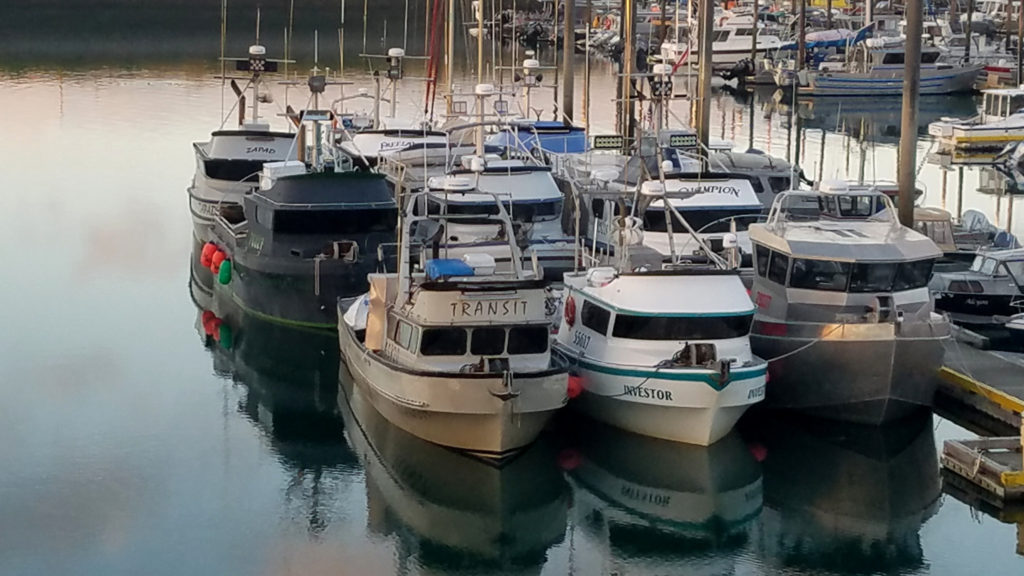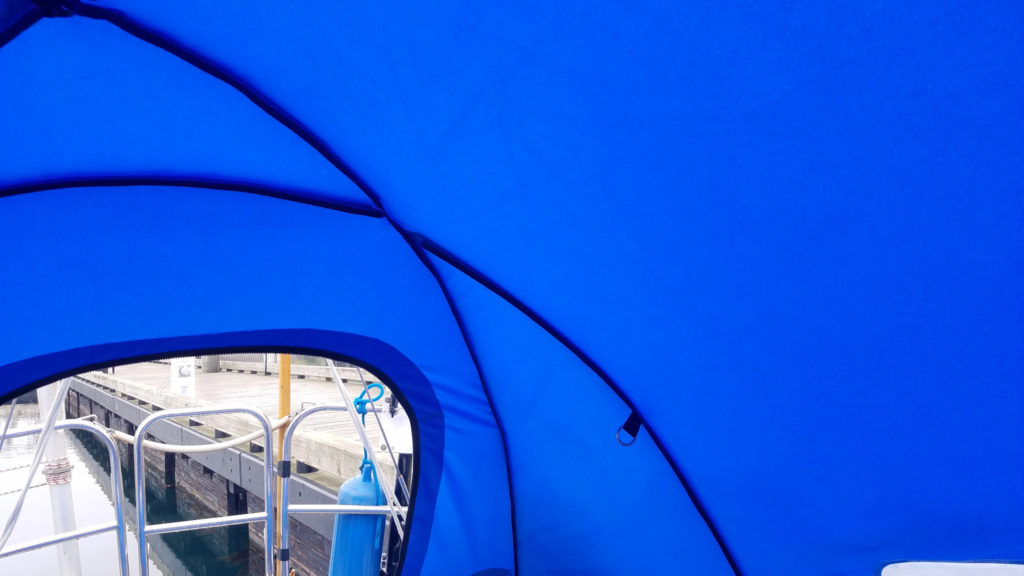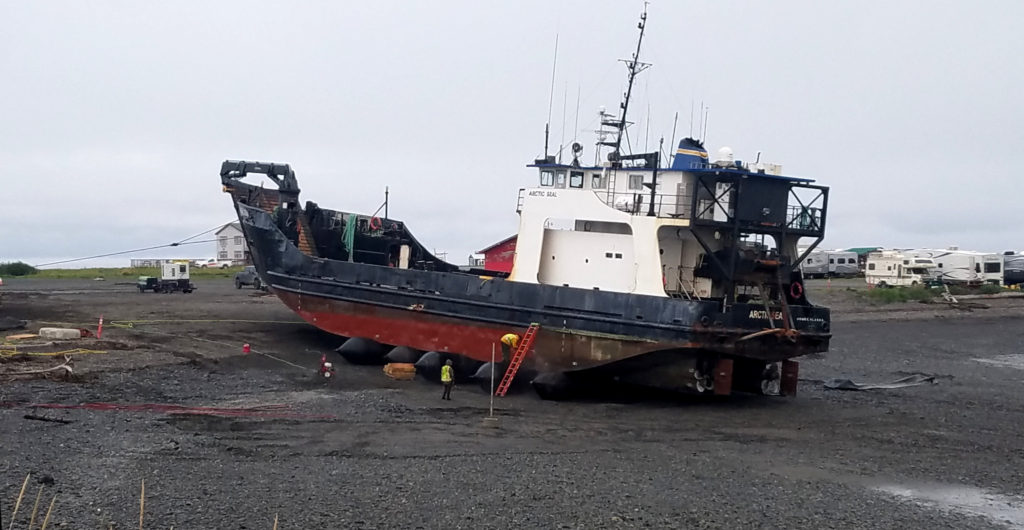Homer Harbor, Homer, AK, 29-AUG-2022 – It happens whenever I live on a boat in a harbor for a while. The water loses the appearance of water and becomes solid like earth or a roadway. It has happened again here in Homer. We’re rafted up next to a Crealock 37 named Trinity. We look forward down a fairway towards the mouth where larger vessels tie up and raft together.
Any time on a boat makes perceptions change. It will seem that the vessel is completely still at anchor or tied up to a dock, but the netting that holds produce rhythmically rocks. It isn’t rocking. It is still and the boat is rocking around it. Any time on a boat produces that perception. But, in a harbor the effect is different. The water (to me at least) takes on the characteristics of a solid.
I searched for a short while to find a way to justify that this is true, heavy objects sink into the earth leaving prints and imprints, but an object with density heavier than the earth under it will not sink until it reaches something with more density. An object with density heavier than water will sink like, well, a brick.
Looking down the fairway boats come towards us in a single line, or two abreast. Generally, they produce little wake and always come closer to us than we expect; it is us who, being rafted up, stick out into the fairway.

The harbormaster told us, by way of explaining why a fishing boat was behaving badly towards us,* that Homer is primarily a commercial harbor. In dollars, I’m sure it is. The number of large commercial fishing boats is impressive. In terms of the number of vessels, recreational boats are a good percentage, if not the majority. Many, many of the recreational boats also do charters, so it can be a matter of how one counts.
There are twenty or more sailboats here. The majority seem to leave their docks during the season. It’s been a few years since Trinity moved.
The truth is that Homer Harbor is just too small for the number of vessels using it. Two-thirds of the participants necessary for a study on expanding the harbor have the money allocated. The state has the money allocated, the city of Homer has, but the feds have not. Everyone hopes that this fall the money will be allocated by the feds. If that happens and everything goes smoothly, the harbor could be expanded by 2028. This all sounds great until I discovered the literature describing the new harbor was printed in 2016. While past performance does not predict the future, this doesn’t look as good as it was described to me.
A large amount of the linear docks are designated transient. The intention is that boats that will not be here permanently will use the transient docks. Those vessels are free to move from transient dock to transient dock. We always ask the harbormaster for advice on where to dock, which we take.
Every marina I can remember in Alaska is owned by the local city or borough. Some docks may be owned by the state, but I can’t think of any formal harbors owned by the state. In all of those harbors, there is no limit on how long one may stay. Here in Homer, seven days is the same fee as a month, six months is the same as a year.
Liveaboards are oftentimes allowed, but as seems to be the case, as housing became less affordable in Homer, liveaboards became forbidden. The definition of liveaboard becomes a little tortured. Two different couples we know wintered over on their boats here in Homer. They weren’t liveaboards presumably because they were only wintering over and intended to leave in the spring.
We do see boats that we suspect are liveaboards with covered-over windows, but we don’t ask and don’t know.
The vessels that come down this far in the harbor are generally forty feet and under. Typically, they are aluminum enclosed vessels available for chartering and many are chartered. Mixed in are open skiffs from 15 feet to over thirty, sailboats less than 40 feet, and 38-foot fishing boats that raft up five boats across and three boats deep (one behind the other). Those vessels tend to be owned by ‘‘old believers,’’ who are of Russian decent and live in enclaves.

Though Russian Orthodox Catholic, they remind me of New York’s Hasidim. They oftentimes dress differently, married women are easily spotted by their colorful headdresses, and flowing, matching dresses. The men often wear embroidered blouses looking like the cast of Fiddler on the Roof. The men I’ve spoken with are friendly, though they seemed to be surprised that I speak with them and oftentimes have accents. I don’t know if men with accents are Russian immigrants, because there are newly arrived Russians in the communities as well.
When I have spoken with the women, they have clear Alaskan accents and have also been very friendly.
The old-believer fishermen are said to be aggressive and hot-headed. My limited dealings with this behavior made me feel like I was back in New York City, where it would not have been out of place.
We have another four days until we are hauled out of the water and then three more before we fly out.
Last fall, I contracted with a man named Josh to build a cockpit enclosure for Caro Babbo. The standard enclosures are made with heavy stainless steel tubing and are more or less permanent. They may fold back, something like a convertible car, but are always there. That style was Josh’s first suggestion. We discussed what he could do, but it really wouldn’t work on Caro Babbo and certainly not on a passage, as I thought we would do more of then.

I had spec’ed out, when we first bought Caro Babbo, an enclosure that was supported by flexible fiberglass tent poles and would fit into a small sack. After discussing this for a while Josh bought in and produced our enclosure, which came out very well. It fits in a sack and weighs about six pounds. Jennifer and I both thought we’d use it at anchor. I figured it would also be great when we have guests staying in the aft cabin so that they would come into a room rather than the open cockpit when they left their cabin. Instead, we found that we didn’t want to lose the view at anchor.

At a dock, it has been great. The cockpit is dry in the morning, it is another room that we can use when it rains.
We have used the enclosure for entertaining. Here where it rarely goes above 60-degree Fahrenheit during the day, the cockpit becomes a hospitable, more open alternative to the main cabin. We’ve done well.
The enclosure covers the aft deck, allowing guests to open the hatch to their cabin and not get wet from the rain. The aft deck is also when the flexible solar panels live. Yesterday, I rigged up a twenty-foot extension cord to allow those panels to be moved to the foredeck. This also means that when the boat is facing the sun, as it is here in Homer, and shadows would fall on the panels even if the enclosure is not up, the panels can now be moved out of the shadows.
I’ll write more about all of this once Caro Babbo is on the hard in the Northern Enterprises boat yard.
We’ve settled in, been entertaining, and preparing for life back in the lower forty-eight.
Jennifer has anxiety dreams about being on the boat. I have anxiety dreams about returning from Alaska. Neither of us is sleeping terribly, but remembering our dreams is not a good sign.
Four days and counting: The fishing boats are building up in the harbor because these are the two weeks this month when boats can be lifted out of the water. The tides are large 19-24 feet. The high tide is high enough that there is water under the North Enterprises dock. It also means that large, shallow draft vessels can be beached, worked on a returned to the water. See picture.

*No, that is not why the commercial fishing boat behaved badly towards us. The commercial fishing boats we meet, and we have now met and dealt with many, many dozens, are considerate, careful and polite. This captain was an inconsiderate aggressive individual.

